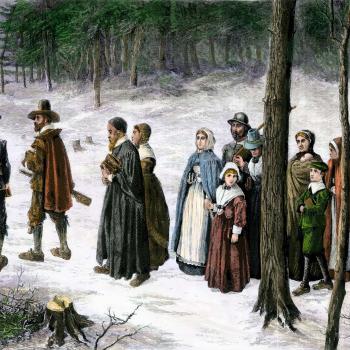I recently came upon an Answers in Genesis article titled Worldwide Flood Legends that left me curious. Growing up in a young earth creationist home, I was told that every culture has flood legends—and that these legends underscore the reliability of the story of Noah’s flood in the Bible. In other words, there really was a worldwide flood. But as I read the legend summaries in the article linked above, I had to wonder. Wasn’t this maybe just a little bit too pat?
Let’s start with this one, for instance:
Hawaii
Nu-u built a large boat to save his family from a flood. When the boat landed safely on Mauna Kea, Nu-u offered pig and coconuts to thank the moon. So the creator descended on a rainbow to reveal that he was the one who saved mankind.
It doesn’t take much searching to find out that nineteenth century missionary activity led to the entwining of the biblical flood story with “both Melanesian and Polynesian legend.” There was no written form of the Hawaiian language before the arrival of Protestant missionaries in the 1820s, after all, so we have no way to compare what this story was before the influence of missionary activity with what it became.
Conveniently, the Answers in Genesis article on “Worldwide Flood Legends” leaves out any mention of missionary activity on Hawaii and the role it played in shaping and curating that culture’s flood legends. Instead, the article simply presents the legend in its final form, as though it were developed independently. It wasn’t.
Let’s look at the next one:
American Plains
Giants on the earth offended their creator, Ti-ra-wa, so he drowned them in a flood. Then he made the first man and woman, who became the ancestors of the Pawnee people.
It should be obvious from the outset that we are going to have a similar problem here. The same Protestants that sent missionaries to Hawaii sent missionaries to the Pawnee. The Pawnee, too, did not have their own system of writing. Their stories were written down by missionaries and settlers.
There’s another issue with Answers in Genesis’ claims here—they leave out the elements that don’t fit the narrative they are selling. For example, this flood was a regional flood.
I should make it clear that I am not suggesting that the Pawnee and the native Hawaiians didn’t have their own flood stories before the coming of missionaries. They probably did. After all, floods occur in both locations—it makes sense that their oral cultures would include stories about them. I am suggesting, instead, two things.
First, missionaries frequently engage in a form of syncretism, finding and emphasizing similarities between a culture’s stories and their religion’s stories. In oral cultures in particular—where a culture’s stories were never written down independently before the contact—these stories then change, shaped and curated and guided by missionaries and their converts.
Second, Answers in Genesis pulls out the closest similarities in these stories—the parts of the stories most likely to have been shaped by missionaries—to prove the point they are trying to make about universal flood narratives that mimic the biblical story, while leaving out aspects of the stories that do not align as well with this story (which are perhaps the oldest elements).
There’s another piece, too—suppose a missionary or an explorer writes down an oral culture’s stories as soon as they arrive, before there is time for these stories to change. Even here, these stories would be curated through the missionary or explorer, who would write the story down in a language and framework he understands, including the parts that stick out to him and perhaps leaving out parts that seemed confusing or unintelligible.
At the very least, to maintain transparency, Answers in Genesis ought to leave out stories that were not written down before the coming of missionaries or explorers. And yet, most of the stories they include are exactly this—stories influenced by and written down by missionaries and explorers.
Peru
The creator, Viracocha, sent a flood to destroy the unruly giants he had made. Only two giants survived in a boat, which landed at Tiahuanaco. The creator then made animals to fill the earth, and he made people from clay.
As in previous cases, Incan stories underwent syncretism resulting from missionary activity.
There were also multiple different versions of this story, a fact which Answers in Genesis’ treatment elides. In one story, Viracocha created giants out of stones, but after the found them brainless he drowned them all and created people out of smaller stones. There was no boat in this story. In another, Viracocha destroyed the area around Lake Titicaca with a (regional) flood, saving only two people. In some versions, these two people survived by floating in a drum.
But again, all of these versions were heavily influenced by the syncretism that resulted from missionary activity following the conquering of Peru by the Spanish. These stories were not written down before the cultural upheaval that came with Spanish occupation.
Hudson Bay
One of the gods became angry at the giants and decided to drown them in a flood. But he warned a man to build a large canoe. The man sent out an otter, who retrieved dirt from which the man remade the earth.
Really? We’re going act as though the entire Hudson Bay was one culture? This one is so obscure I’m having trouble finding it via google—but here, again, what I said above applies. This was an oral culture that was subjected to missionary influence after the arrival of Europeans.
I get the feeling those working at Answers in Genesis do not know how oral cultures work, or how stories are shaped, and change. Perhaps this is in part because they are so used to being a people of the book—the Bible, after all, is written down and unchanging (well, more or less).
Scandanavia
When Odin killed the first frost giant, Ymir, his blood deluged the earth. The frost giant Bergelmir and his wife survived in a hollowed out tree.
Interestingly, even Norse mythology is not free from syncretism—Christian missionaries spent hundreds of years working to convert those of Northern Europe. In fact, these stories were not written down until hundreds of years after the Norse converted to Christianity—and when they were written down, they were written down by Christian monks and scholars.
Tanzania
God told two men to take seeds and animals onto a boat so they could survive a mountain-covering flood. These men sent out a dove and then a hawk to see if the earth had dried up.
See also, missionary activity to Tanzania. (Also, I had trouble finding any mention at all of this story outside of young earth creationists’ collections of supposed flood stories from around the world).
Akkadia
Angry over human noise, the gods decided to flood the earth. But the kind goddess Ea warned Utnapishtim to build a cube-shaped ark to save his family and animals from the worldwide flood.
Ah. Gilgamesh. Here at last we are getting somewhere.
The Epic of Gilgamesh is the oldest written story known to exist. It was written in 2000 BC. (Scholars believe that the Old Testament, in contrast, was written down after 600 BC.)
This is the closest this list has come to offering a fully independent flood story—but even here we encounter problems. A collection of flood myths floated around the Levant during the bronze age and into the iron age. These myths were likely the result of constant flooding of the Tigris and Euphrates rivers. The thing to bear in mind is that stories passed among these cultures. In other words, these flood myths were not in fact developed independently.
Young earth creationists claim that the Epic of Gilgamesh, like the story of Noah’s flood recorded in Genesis, was passed down through the generations directly from the actual event. The two stories, they claim, are independent evidences that such a flood occurred. The problem is that these stories cannot be claimed to be truly independent of each other. Indeed, it appears likely that the Epic of Gilgamesh, which was well known in the biblical world, influenced the story of Noah’s Flood.
But I’d like to finish going through the flood narratives in Answers in Genesis’ list before I move on to some concluding thoughts.
Western Australia
Gajara and his family survived a worldwide flood on a raft. He then sent birds to see if the waters had receded. Pleased by the smell of cooking kangaroo, the god Ngadja placed a rainbow in the sky to stop the rain clouds.
See also missionaries. And like the story from Tanzania, I am having trouble finding any telling of this story outside of creationist websites.
China
When a sky god flooded the earth, a brother and sister survived on a boat. They had a deformed child, which the brother cut into pieces. The earth was repopulated from the pieces.
Weirdly, this is not the most common Chinese flood myth. China, like the Levant, had issues with rivers and flood control. As for the particular myth told here, it does not appear to have been written down until after missionary influence (it is believed to have originated among the Miao people, and it was missionaries who created the Miao people’s alphabet).
And now we have reached the end of this list, although other young earth creationist websites offer still longer lists. As I conclude, I would like to make there points.
1. Growing up, it was never mentioned to me that many of the flood myths I was told about from around the world were only written down after these cultures were influenced by Christian missionary activity (and indeed, the stories were often written down by Christian missionaries or other westerners). This matters—a lot. It means these stories were not truly independent.
2. That many cultures would have flood myths does not mean that there was a global flood. Indeed, many cultures’ flood stories only allege a regional flood, and flood myths appear to play a much greater role in regions prone to flooding than in other areas of the globe. People created myth to understand they world. Flood was one thing they needed to understand.
3. The reason creationists’ lists of flood stories from around the world are so striking has more to do with the similarities than anything else. However, the striking nature of these similarities is dependent on seeing these stories as developing independently from one another—and they did not. In addition to missionary activity, there is the reality that the Epic of Gilgamesh had already circulated widely throughout the Middle East before the composition of Genesis.
One creationist article puts it like this:
Perhaps the second most important historical account of a global flood can be found in a Babylonian flood story in the Epic of Gilgamesh. When the Biblical and Babylonian accounts are compared, a number of outstanding similarities are found that leave no doubt these stories are rooted in the same event or oral tradition.
The author claims that the biblical account and the Epic of Gilgamesh were without a doubt “rooted in the same event or oral tradition.” Well … yes. But those two things—event or oral tradition—are not identical. The author alleges that the two stories are rooted in the same event—they are both retellings of the same actual flood, that of Noah. What he doesn’t seem to understand is that it is far more likely the the two stories are rooted in the same oral tradition—not an event.
I took some courses in classics in my undergrad, including classes on ancient myth. Scholars of myth frequently look at the ways stories change over time—and the ways one story influences another. It is possible that there was a specific, large regional flood that spawned the Epic of Gilgamesh and the story of Noah’s flood. It is more likely that the Epic of Gilgamesh, which was written down far earlier and had a far wider spread, influenced the story of Noah’s flood.
I have a Patreon! Please support my writing!















